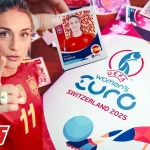The Future of Shopping Isn’t Just Online; It’s in the Ad Itself
Bridging the Gap Between Browsing and Buying. Shopping has evolved from window displays to instant clicks, and now, shoppable ads are rewriting the rules. These dynamic ad formats erase friction, turning inspiration into immediate action. As e-commerce and digital advertising merge seamlessly. Brands must rethink engagement, because the future of shopping isn’t just online; it’s in the ad itself.
As the name suggests, a shoppable ad is an ad where viewers can make purchases directly from the advertisement.
Digital channels are developing ways to streamline consumers’ purchase journeys by eliminating obstacles between seeing an ad online and buying the product it sells. This has resulted in Shoppable Ads, ad formats specifically designed to capture and convert online shoppers.
A research study conducted by Insider Intelligence in 2023 found that ad agency professionals worldwide considered shoppable video content was the next big trend, with 57% attributing to this view. This was followed by increased personalisation by 53% and Omnichannel audience tracking by 52%.
Shoppable Video Ads
Shoppable video ads have proven effective in their performance by cutting through the noise and boosting viewer engagement. In 2023, people watched over 30 billion hours of shopping-related ads on YouTube. Is it not that e-commerce and digital advertising work hand in hand in mutually beneficial ways?
Shoppable video ads increase advertising effectiveness multiple times over. E-commerce advertisers use shoppable ad formats to create a frictionless journey from viewing the ad to buying the product.
It is a gift of the digital age that enables people to view the ad and purchase products on the same device. Contrast this with how they used to learn about a product from a billboard, television, or print ad. And hoped to find it in some brick-and-mortar store if it was available in their area. Now they can research, learn about, and buy products on a single device with just a few clicks.
Shoppable ads are available on many platforms, including Facebook, Instagram, Google, Pinterest, Interactive TV, and YouTube. These ad formats provide a digital storefront to e-commerce brands integrated with their e-commerce sites and other online platforms such as Google Merchant Centre Account.

Shoppable ads on Facebook fast-track the discovery-to-checkout process. Product collections appear in In-Feed and consist of a featured video or an image followed by four product images.
The featured video captures attention, holds it, and then diverts it towards the products. When someone clicks the ad, they are quickly taken to a full-screen storefront where they explore related products, see their prices, and click through to their e-commerce pages.
Shoppable ads on Pinterest begin with a hero image or a video that appears within a feed. When a viewer clicks it, the hero image or video is enlarged. Featuring up to twenty-five related products appearing beneath it, each linking to their buying pages. This image or video is like a mini storefront where e-commerce brands can group related products into collections.
Instagram shoppable ads allow brands to add a shopping tag so users can learn more about the featured products or buy them. They appear in In-Feed and its ‘Explore’ section. Displaying a single image or multiple images to form a carousel with video functionality.
E-commerce brands advertising on Instagram can enable checkout on their shoppable ads. Allowing users to purchase the promoted product without leaving the app, making the buying experience seamless.
TikTok
TikTok is yet another social media platform featuring shoppable ads. It allows viewers to browse and purchase products from their TikTok shop or the For You page. Shoppable ads increase sales and enhance user experience by seamlessly taking them from the ad to the checkout.
YouTube
YouTube used to have the TrueView for Shopping format, which added a shoppable experience to video ads. But now, it has allowed all of its ads to have a shoppable functionality. Advertisers connect their Google Merchant Center feed with their video ad, creating a Call to Action (CTA), and featuring a range of hyperlinked products.
The storefront of product images builds upon the awareness and consideration stages achieved through the main video, providing an actionable element and helping brands convert leads better by driving them toward related product pages.
Google’s shoppable ads allow customers to buy products directly from Google Images, YouTube, Gmail, and other Google platforms. Google Shopping ads use data from Google Ads and Google Merchant Centre to show customers what you offer.
Google Shoppable ads appear at the top of search results when you search for a product. They include images and information about the product, such as its price, colour, and size.
Gmail shoppable ads are solo ads that show users products uniquely relevant to them and are selected based on their online activity and interests. They appear under the Promotions and Social tabs of Gmail, and users can click on them to expand and see more details about them and images of the products. They can visit the e-commerce website to buy them.
Shoppable TV Ads
It is not only social platforms that are bringing in the shoppable action. TV is now adopting shoppable elements to help drive e-commerce purchases. These elements are built in to help TV services provide brands with a direct response-focused ad unit that can drive immediate action.
NBCUniversal began rolling out shoppable TV ads in 2019, using QR codes to allow viewers to scan and purchase products featured on the show they are watching directly from their phone. NBCUniversal began rolling out shoppable TV ads in 2019, using QR codes to allow viewers to scan and purchase products featured on the show they are watching directly from their phone. This process has been taken even further with the announcement of NBCUniversal Checkout, which allows for a native shopping experience embedded in content.
Impact on Sales Funnel
Shoppable ads have consequences for the famous sales funnel. They reduced the steps in the funnel to only three: awareness, consideration, and purchase, as they allow consumers to buy products straight from the ad without needing to leave the platform.
“Shoppable ads collapse the funnel in a way we’ve never seen before. Upper funnel ads are now simultaneously direct response ads—they’re the same.” – Venture Beat.
Shoppable ads help build a community of loyal customers who share their opinions and experiences with the brand and other shoppers. In short, shoppable ads will revolutionise e-commerce as we know it today.










